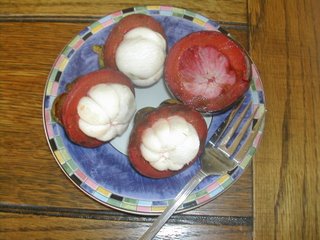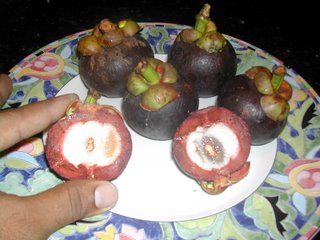These beautiful fruits are mangosteens. Oddly, you don't eat that yummy looking red part − it's very bitter. The white part in the center looks like soft garlic cloves but don't let that fool you. It is melt-in-your-mouth luscious: very sweet and creamy, a little citrusy, maybe with a touch of peach flavor. Oh, here, I found a much better description:
"I cut open a thick rind to reveal six snowy white, almost translucent segments that were like little eggs nestled in a jewel box. The flavor was almost unbearably exquisite - a sweet-tart melding of elegance and opulence that had echoes of fruit of every climate. Think of cherimoyas, lychees, and peaches mingled into one soft, moist, fragrant mouthful. I understood at last why many people consider mangosteen the finest fruit in the world-and why Queen Victoria is said to have offered a knighthood to anybody who could bring her one."They were for sale yesterday at the local grocery store for the very first time that I'm aware of. It seems that a local engineer grows them for export (so what else is new?), but this time decided we lowly Ceibeños were Mangosteen-worthy. Hooray! They cost 2 lempiras each here (about 10 cents).
-David Karp, The Fruit Detective, Meet the Mangosteens, Gourmet Magazine, July 2003, pp. 88-89
 After doing some research, I found that this is the proper way to cut and serve the fruit. It does look more attractive this way, doesn't it?
After doing some research, I found that this is the proper way to cut and serve the fruit. It does look more attractive this way, doesn't it?Recently, a company has been promoting a mangosteen juice which costs $39.95 for a 25 ounce bottle! Another company sells a 'bargain' version, $24.95 for a 32 ounce bottle. If nothing else, this should tell you how good this fruit is! I'm not going to promote these companies by naming them, but I will tell you that they make wild claims about the health effects of this juice. I intended to say that they claim it does everything except cure cancer, but then I read further and it seems that they hint at that, too. It is true that the fruit is high in vitamins and anti-oxidants and has been used in many folk remedies for hundreds of years. But I don't believe the rest of that stuff for a minute.
Garcinia mangostana L. is a native tree of Malayasia and now is widely grown in southeast Asia, India and to a lesser extent in Hawaii and many other tropical countries in the Americas, Africa and Australia. It has not been successfully grown in Florida or California. Honduras is said to have one of the largest plantations in the world (500 trees) at the Lancetilla research gardens. Started in 1927, it still produces fruit today.
Despite the name, mangosteen is not related to the mango family. The fruit is the most generally esteemed of all tropical fruits, called the queen of the fruits in many countries. The tree is grown only in tropical areas that have heavy rainfalls. It is a dense shade tree, nicely pyramidal in shape, growing from 30 to 80 feet tall depending on the soil and climate. It fruits twice a year but not reliably so in climates that don't have a sufficient dry season. CURLA recommends it be grown in Honduras only from sea level to 500 meters in areas with at least 2 meters of annual rain. In other areas it has been grown to an altitude of 1,500 meters.
The most unusual fact about mangosteens is that they are dioecious but apparently no one has ever identified a male tree. Like many mysterious things in nature, the female tree has adapted and found a way to reproduce.
You might logically ask: "If mangosteens are so great, why don't we see them in the U.S.?" Good question, since all things good generally go to the U.S.
Fresh mangosteens are forbidden by the U.S.D.A. for importation from southeast Asia due to the possibility of importation of fruit flies. Currently, the fruits may only be imported from Puerto Rico and 18 Central American and Caribbean countries, none of which have many successful commercial growers. A change has been recently proposed to allow importation of irradiated fruit from Thailand. Mangosteens must be harvested fully ripe and the fruit does not ship, preserve, or process well.
It is a slow growing tree, requiring shade for the first two to three years. Tests over the last 75 years have proven that it cannot be reliably propagated vegetatively so growing from seed with the resultant long wait, is the best alternative. It can take 8 to 10 years, sometimes even up to 15 years, to produce fruit. The first few years of harvest can range from 300 to 500 fruits, increasing to about 500 for a full grown tree, and reaching optimum production of 1,000 to 3,000 fruits after 20 to 30 years. It takes a patient and optimistic farmer to decide he wants to grow mangosteens for profit.
 This is a picture of my mangosteen tree. Actually it is better described as a Mangosteen twig. The wood slats around it are for Rottweiler protection. After reading all the research, I realize now that I need to give it more shade. It is not a well-known tree in Honduras. CURLA, the national agricultural university of Honduras, grows and sells a few plants to the public. Sadly, only these very small trees are available. The price was right, though: L. 20 (about $1.05 U.S.) In Honduras, mangosteens typically do not fruit until the 8th year so I have a very long wait for mangosteens of my own.
This is a picture of my mangosteen tree. Actually it is better described as a Mangosteen twig. The wood slats around it are for Rottweiler protection. After reading all the research, I realize now that I need to give it more shade. It is not a well-known tree in Honduras. CURLA, the national agricultural university of Honduras, grows and sells a few plants to the public. Sadly, only these very small trees are available. The price was right, though: L. 20 (about $1.05 U.S.) In Honduras, mangosteens typically do not fruit until the 8th year so I have a very long wait for mangosteens of my own.If you want to know more about mangosteens including it's history, culture, and folklore, check out Fruits of Warm Climates. For the straight scoop on those juice products, see Science, Nonscience and Nonsense at Mangosteen.com. Mangosteen.com also provides some interesting, well-documented history of the mangosteen, including a 1855 story of a greenhouse-grown tree in England that produced its first fruit after 22 years of growth. The author also debunks the Queen Victoria story above.
If you come to Honduras in 2014, stop by La Gringa's house and I may be able to offer you a mangosteen juice − for free!
More on Mangosteen: Mangosteen revisited



 Welcome to my Blogicito —
Welcome to my Blogicito — 







